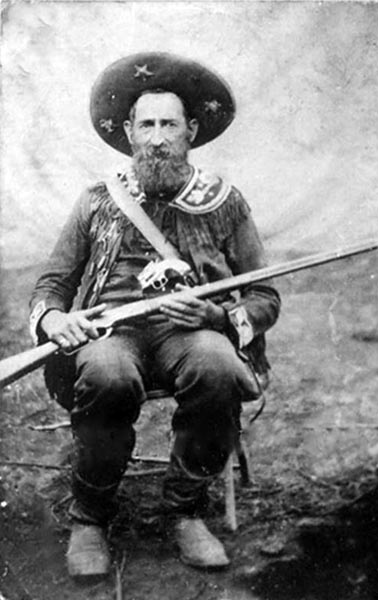"Devil Anse" Hatfield: Soldier, Farmer, Feudist, Movie Star?
By Randy Marcum

In this photo from about 1910, Devil Anse looks like he's better prepared to fight Mexican revolutionaries than McCoys.
Courtesy of the Coleman C. Hatfield Collection, F. Keith Davis.
“Abashed the devil stood and felt how awful goodness is.” –John Milton, Paradise Lost
Anderson “Devil Anse” Hatfield was many things to many people throughout his long life: leader of the Hatfield clan; vengeful executioner; loving husband to his wife, Levicy (Chafin) Hatfield; devoted father to his children; and eventually a showman who entertained thousands.
I’ve been researching the Hatfield-McCoy Feud for years. Popular topics like the feud have been covered so thoroughly, you often think you’ve heard it all. But, one day, I was looking through some old newspaper clippings and found a reference to 74-year-old Devil Anse hitting the Vaudeville stage in Charleston. Devil Anse Hatfield: Song-and-Dance Man? No, as newspaper accounts of the day attest, even if he’d had the talent for it, he suffered from frequent bouts of stage fright It turns out he was getting paid to talk on the Vaudeville circuit about the violent days of the feud—or at least his version of it.
Devil Anse certainly didn’t invent the idea of making money based on his celebrity. Even before the dawn of radio, television, or the Internet, famous people often cashed in on their celebrity status. Perhaps the most famous from that time period was “Buffalo Bill” Cody, who took his Wild West show around the world. In the late 1800s, Martinsburg native Belle Boyd had a popular stage act. The most famous spy of the Civil War appeared before sold-out houses across the country, revealing how she’d lured Northern officers into divulging top-secret military information.
While Devil Anse’s nickname implies a sinister personality—and some of his actions certainly bear this out—he was also a natural entertainer. This is apparent in stories he told to his family, friends, and casual acquaintances, and even in his tongue-in-cheek visit with journalist T. C. Crawford, who wrote the first nationally published—and highly sensationalized—accounts of the feud. Even Hatfield family photographs reveal a sense of humor, which could drift toward the dark side at times. All the while, he also wasn’t averse to exploiting his notoriety—or possibly notoriousness—for a dollar or two.
By late 1913, the entertainment bug had bitten Devil Anse. National newspapers were reporting on his contract to appear on the Vaudeville circuit. Not only was he capitalizing on his own fame, he was taking advantage of his famous nephew, the newly inaugurated Governor of West Virginia Henry D. Hatfield.
During 1914, Devil Anse increasingly built a larger audience. By this time, many of the feud’s main players had left their mortal coils. Several McCoy children had died by 1888—at least five directly at the hands of the Hatfields. McCoy family lawyer and provocateur Perry Cline had died in 1891. Finally, on March 28, 1914, Randolph McCoy—perhaps the most tragic figure in the entire feud—died from burns he suffered in a kitchen fire. As such, Devil Anse felt unleashed to tell whatever version of the story he wanted to tell, and audiences were more than willing to spend their hard-earned money to listen to stories of the Devil.
Some 25 years after the main events of the feud had ended, the public’s interest in the Hatfields and McCoys was stronger than ever. A short movie that referenced the feud was released in 1914. A Feud at Beaver Creek, produced by early filmmaker Thomas Ince, was billed as “a strong two-reel drama dipicting (sic) the early days of the famous Hatfield-McCoy fued (sic) of West Virginia and Kentucky. A picture that is bound to please.” It played at The Rex in Bluefield in August and in theaters across the country during the following months. While the movie is little remembered, its producer is part of Hollywood lore. Ince died suddenly in 1924 at age 42 of either a mysterious illness or the result of a fatal gunshot fired by newspaper publisher William Randolph Hearst. According to the more exotic version of his death, Ince was shot accidentally by Hearst with a bullet intended for film legend Charlie Chaplin, who was having an affair with Hearst’s mistress, Marion Davies. The cause of Ince’s death is still debated as one of Hollywood’s great mysteries.
You can read the rest of this article in this issue of Goldenseal, available in bookstores, libraries or direct from Goldenseal.